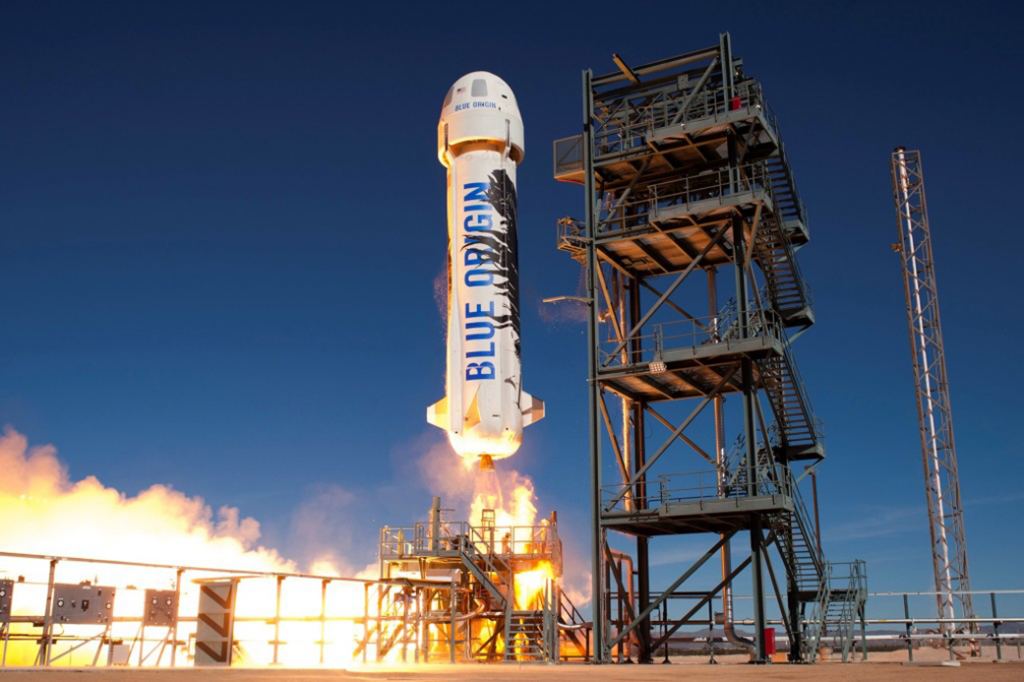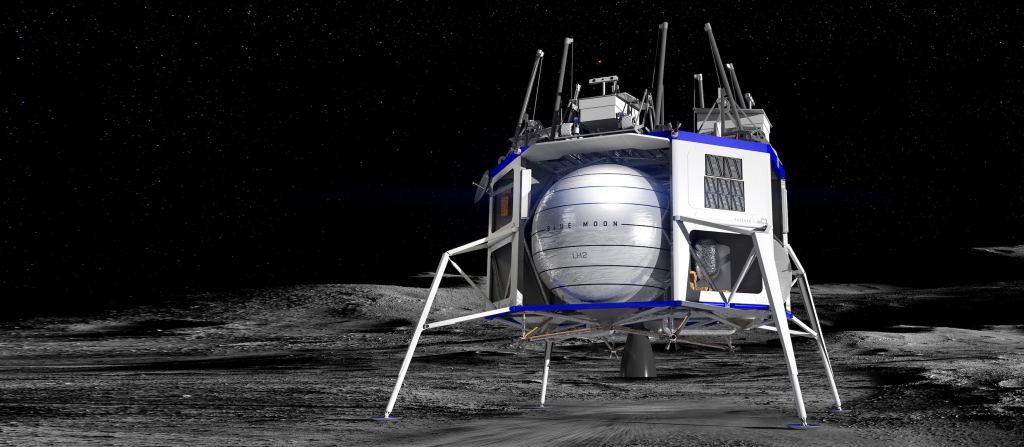Once He Steps Down From Amazon, Jeff Bezos Will be Able to Focus his Energy on Blue Origin
By Matt Williams
When it comes to the private aerospace sector (aka. NewSpace), some names stand out from the rest. The most obvious of these is SpaceX (the brainchild of Elon Musk and the leading source of innovation in commercial space) and the United Launch Alliance (ULA), a joint venture between Boeing and Lockheed Martin. But what of Blue Origin, the private aerospace company created by Jeff Bezos in 2000?
In recent years, Blue Origin has fallen behind the competition and missed out on several billion dollars worth of contracts. But with Bezos stepping down as CEO of Amazon, industry sources have indicated that this could change soon (according to Eric M. Johnson at Reuters). With all of the opportunities available for commercial space, Bezos is now in a position to take a more hands-on role as the company faces a most pivotal year.
Bezos’ decision to step down as the CEO of Amazon, the global powerhouse for e-commerce that he founded over twenty-seven years ago, was announced earlier this month. As Bezos indicated, he will be assuming the role of Executive Chair of Amazon’s Board of Directors by the third fiscal quarter of the year (between July and Sept.) while Andy Jassy – founder and CEO of Amazon Web Services (AWS) – will replace him as CEO.

The former CEO shared his reasons in an email to the Amazon staff, which was issued on Tuesday, Feb. 2nd:
“Being the CEO of Amazon is a deep responsibility, and it’s consuming. When you have a responsibility like that, it’s hard to put attention on anything else. As Exec Chair I will stay engaged in important Amazon initiatives but also have the time and energy I need to focus on the Day 1 Fund, the Bezos Earth Fund, Blue Origin, The Washington Post, and my other passions.”
According to industry sources, Bezos’ decision will be a boon for Blue Origin, which has struggled to keep up with the competition in recent years. In the past two years, the company has failed to secure a National Security Space Launch (NSSL) procurement contract, which led the U.S. Space Force to officially terminate their launch technology partnership with Blue Origin on Dec. 31st, 2020.
While the company has secured some contracts and investments, the vast majority of funding since 2016 has come from Bezos’ himself. Since 2017, he has been selling approximately $1 billion USD in Amazon stock each year in order to keep Blue Origin financially afloat. In addition, the development of Blue Origin’s spacecraft and reusable systems has moved at a rather slow pace in the past few years.
The New Shepard suborbital launch vehicle, for example, completed its first flight test on January 14th, 2021, almost ten years after making an initial attempt (which was a partial success). The New Glenn rocket, a two-stage orbital launch vehicle, began development in 2012 and was publicly announced in 2016. However, progress on this rocket has also been limited and its first flight test is tentatively scheduled for sometime later this year.
Some progress has been made in recent years, though. In April of 2020, NASA announced that Blue Origin was one of three companies competing to develop a Human Landing System (HLS) for Project Artemis. SpaceX and Dynetics also secured spots in the competition, and all three are submitting proposals for a reusable lander system that will ferry astronauts to the lunar surface (either from the Orion spacecraft or Lunar Gateway).
Given the scope of Artemis, which will entail regular trips to the lunar surface and the creation of a base camp on the surface, this competition could potentially mean multibillion-dollar contracts for the foreseeable future. According to the industry sources, Bezos and other executives at Blue Origin are therefore focused on partnering with NASA to secure the lunar lander contract and execute its development.
Competition is expected to get more intense this year, as NASA is expected to narrow the lunar lander contests to two concepts. At present, Blue Origin is tasked with reducing the size and weight of its lander to make it fit on the available commercial launch vehicles – which include the SpaceX Falcon Heavy and ULA’s Vulcan Centaur. Blue Origin also hopes to have its New Glenn rocket ready in time so they can provide launch services themselves.
According to another industry source, Blue Origin has reportedly modified its design since last April and is ready to meet its contractual specifications. Nevertheless, there is much work that needs to be done in order to get Blue Origin to the point where it is profitable and capable of competing with other heavy-hitters in the NewSpace industry (particularly SpaceX).

These are said to include technical and production challenges, issues with procurement, bureaucratic processes, high overhead costs, and engineer turnover – all of which have emerged as the company made the transition from development to production. Given the lofty goals with which it was founded, it is understandable why Bezos is looking to give Blue Origin more of his attention.
Founded in 2000, Blue Origin has grown to include a workforce of 3,500 employees and manufacturing and launch facilities in Texas, Florida, and Alabama. Since then, its programs have expanded to include heavy-lift launch services for commercial partners, suborbital tourist flights, and the crew-capable lunar lander – Blue Moon, which the company’s HLS concept is a variant of. Unfortunately, none of these are ready for commercial use.
Meanwhile, SpaceX (which Musk founded in 2002) has realized its goals of developing reusable rockets for commercial use with the Falcon 9 and Falcon Heavy. It also provided both the launch vehicles and crew capsules (the Crew Dragon) used for NASA’s Demo-2 and Crew-1 missions. These two missions effectively restored domestic launch capability to US soil for the first time since the retiring of the Space Shuttle Program in 2011.
SpaceX is also pushing ahead with the development of the Starship and Super-Heavy, a totally reusable launch system that will be capable of transporting up to 100 metric tons (110 US tons) to Low Earth Orbit (LEO), as well as sending crew and cargo missions to the Moon and Mars on a regular basis. So far, two three-engine prototypes of the Starship (SN8 and SN9) have conducted high-altitude flight tests and the development of the Super Heavy booster is proceeding apace.

Other ventures that Bezos has publicly talked about include Project Kuiper, a constellation of 3,200 satellites that will provide global broadband internet access. Amazon has not launched any satellites yet but hopes to have half of its constellation (1,600 satellites) in orbit by 2026. This constellation will be one of Starlink‘s chief competitors, which has launched 1,145 satellites to date and is adding batches of 60 per launch.
Over the years, Bezos and Musk have squared off more than once, especially where issues of “who thought of it first” occurred. Both men founded private aerospace companies with the dream of making space travel more accessible, both expressed interest in conducting landings at sea early on, and both are hoping to break into the burgeoning space tourism industry.
And the less said about which of them is richer, the better! (It’s Bezos, again!) But competition is always healthy when it comes to innovation and space exploration. Just look at what came of the Space Race, where the US and the Soviets spurred each other on to accomplish amazing feats that altered the course of history. Luckily, this competition won’t involve nukes and mutually assured destruction!
Further Reading: Reuters
The post Once He Steps Down From Amazon, Jeff Bezos Will be Able to Focus his Energy on Blue Origin appeared first on Universe Today.

February 20, 2021 at 04:46AM
via Universe Today read more...

Post a Comment